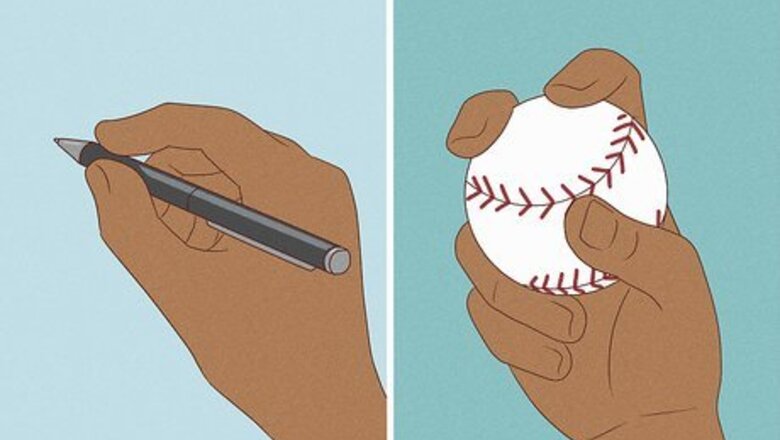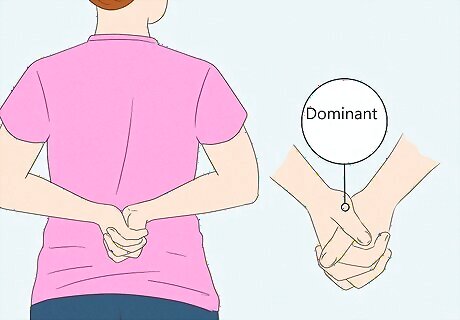
views
- Find your dominant hand by writing a sentence or your name with both hands to see which one you favor.
- Eat with a fork or spoon using both hands. The one that’s easiest to use is likely your dominant hand.
- Throw and catch a ball with one hand and then the other. The hand you can throw better with is probably your dominant hand.
What is a dominant hand?

A dominant hand is the hand you use the most for motor skills. Think about the hand you instinctively use when reaching for something, writing something down, or throwing a ball—this is your dominant hand. Most people are right-handed (meaning that their right hand is their dominant hand), whereas 10 to 12% of the population are left-handed. Hand preference develops and solidifies throughout early childhood, and dominance is usually apparent and fixed by the end of infancy. Some scientists believe that your dominant hand is all up to genetics, while others argue that it’s a product of your environment. In contrast, your non-dominant hand is the hand you use the least. For instance, if you’re right-handed, your non-dominant hand is your left hand. You may also hear the term “ambidextrous” when talking about dominant hands. An ambidextrous person is someone who can use both of their hands alike—both of their hands are dominant.
Dominant Hand Tests

Hold a writing instrument and write a sentence. A stylus, pencil, or pen will do. Write something with a pen or pencil on a piece of paper with one hand. Once finished, write the same sentence using your other hand. Make a note of which hand you were using when you wrote the clearer version of the sentence. People are often forced to choose a specific hand to write with when they’re little, so you may naturally prefer using one hand to write, even if you prefer to do everything else with your other hand.

Draw several shapes and figures. Pick a hand and draw a circle, a square, and a triangle. Then, draw the same shapes with your other hand. Compare your drawings, and note which hand produced clearer lines and more accurate shapes.

Pick something up. Find several objects and place them directly in front of you. Pick it up without consciously choosing a hand. Take note of which hand was used more frequently. This exercise will likely need to be done multiple times to avoid accidental bias.

Use eating utensils. Try bringing food to your mouth with a spoon or fork. Make a note of which hand is easier to use and if that preference changes depending on which utensils you use (fork and knife, chopsticks, fork, spoon). Most utensils don’t have a hand-bias and are simple to operate, but you still might want to repeat the test until a preference is clear.

Color in a drawing. Print out 2 identical coloring pictures of something relatively easy to color, like a teddy bear. Color each copy of the picture with a different hand, aiming to stay within the lines. Make a note of which hand was the easiest to use and which picture is the neatest.

Cut shapes out of a piece of paper with scissors. Draw 2 identical simple shapes (circle, triangle, or square) on 2 separate pieces of paper. Then, use one hand to cut out one shape and the other to cut out the other shape. Compare how well you cut out each shape with each hand. Make sure the scissors you use are non-handed, as left- and right-handed scissors can only be used comfortably in the assigned hand.

Throw and catch a ball. Toss a ball up in the air and catch it with the same hand. If you have a friend, ask them to play catch with you. Notice which hand you instinctively want to use and which is easier to throw and catch the ball with.

Clap your hands. Without thinking, clap your hands. People who are right-handed typically clap with their right hand on top of the left, while left-handed folks put their left hand on top.

Fold your arms. When you cross your arms, which arm comfortably goes on top? Right-handed people usually put their right arm on top, while left-handed people put their left on top.

Clasp your hands behind your back. Hold your hands together behind your back, pushing out your chest. Which thumb is on top of the other? If you’re right-handed, the right will be on top. If you’re left-handed, the left will be on top.

Make a list of which hand you preferred in each test. Tally up the number of times you used each hand in the tests above. Then, determine which hand you used the most often. This is likely your dominant or most preferred hand. The hand you predominantly used in writing and drawing often identifies which handedness you have, as it’s the most socially relevant, apparent, and distinctive activity impacted by handedness.













Comments
0 comment